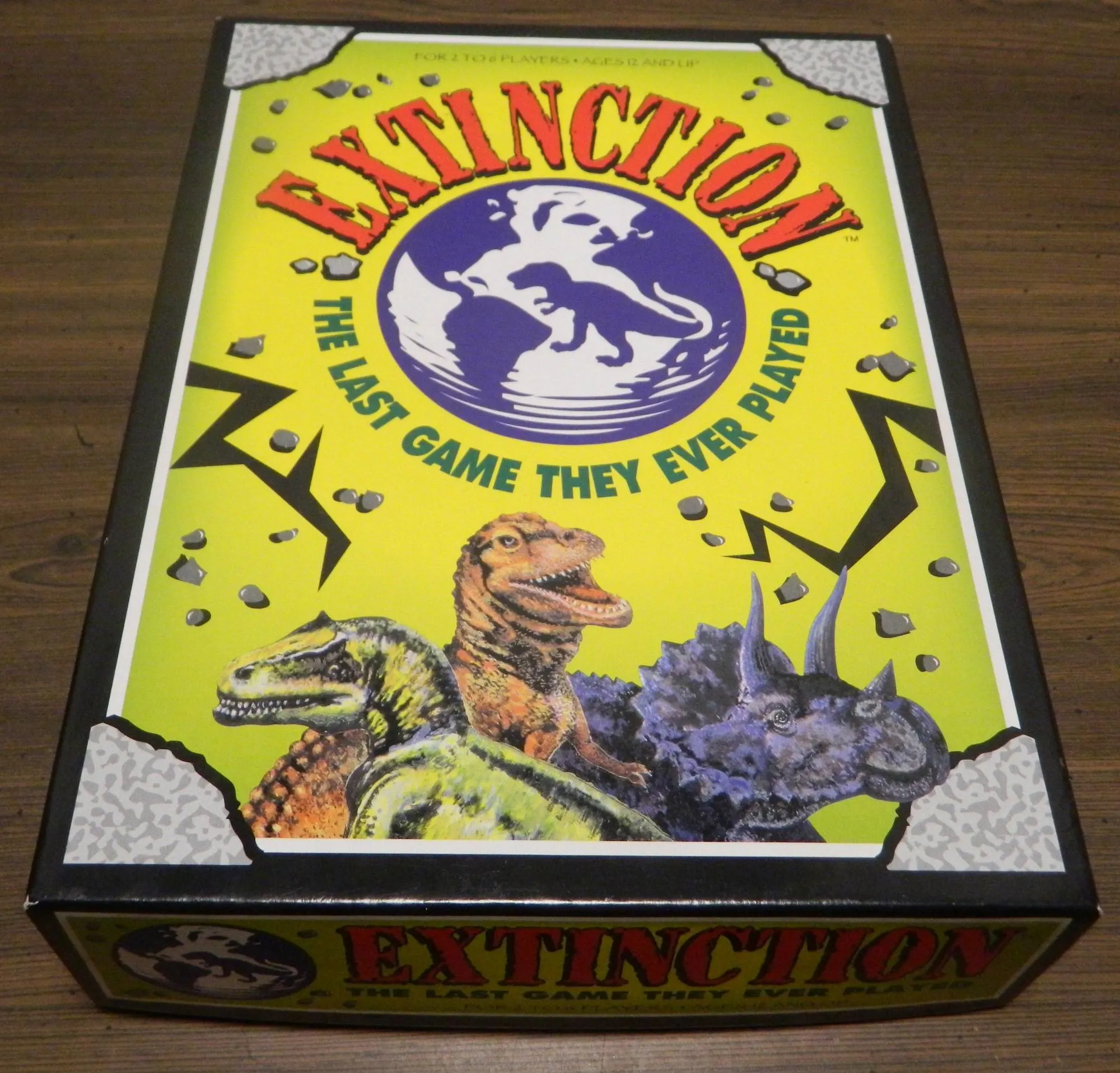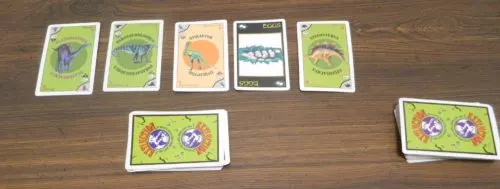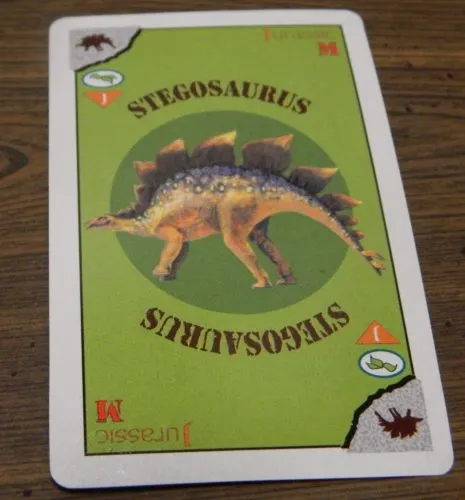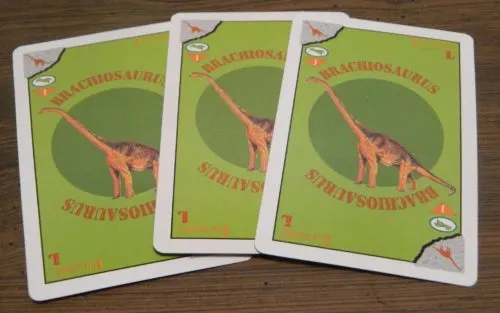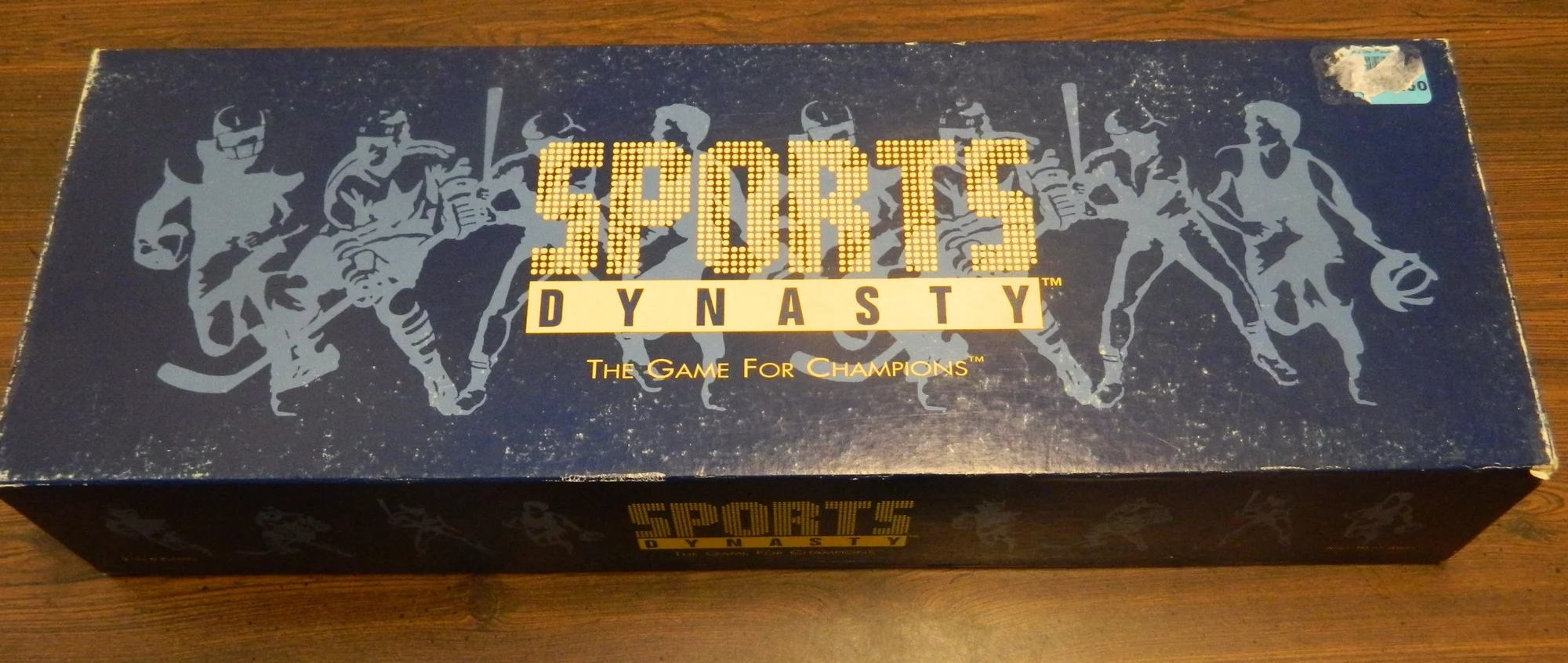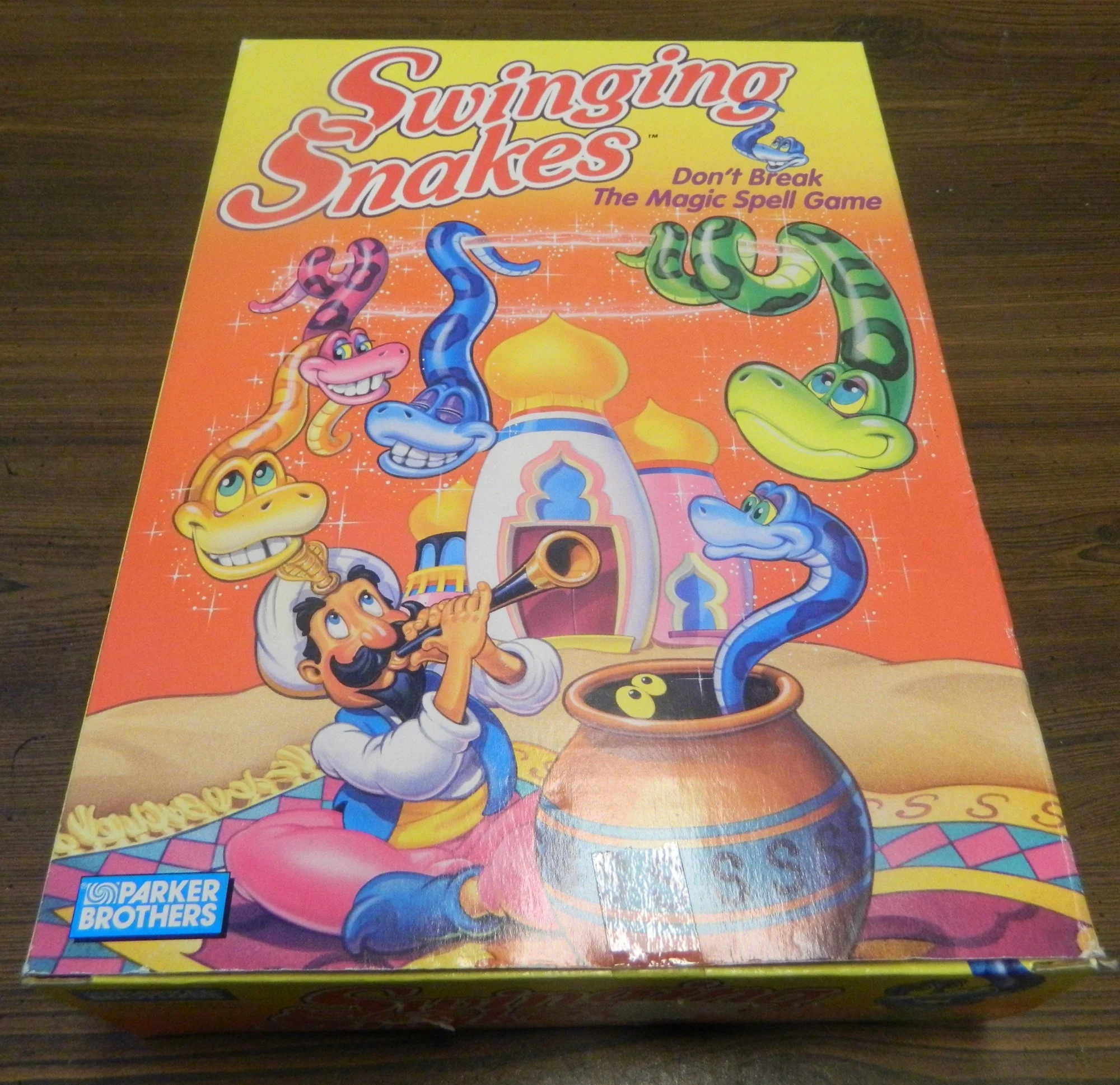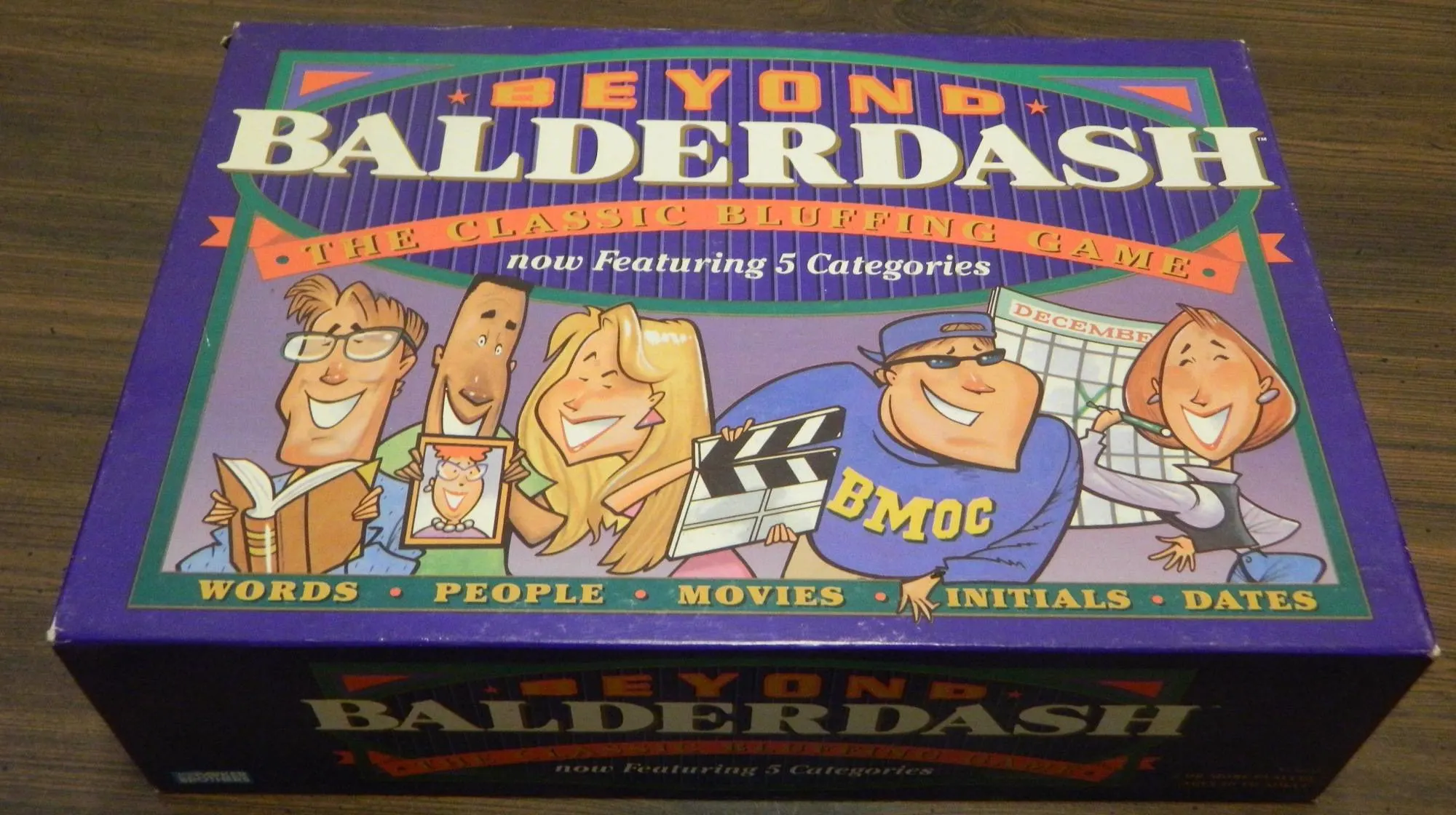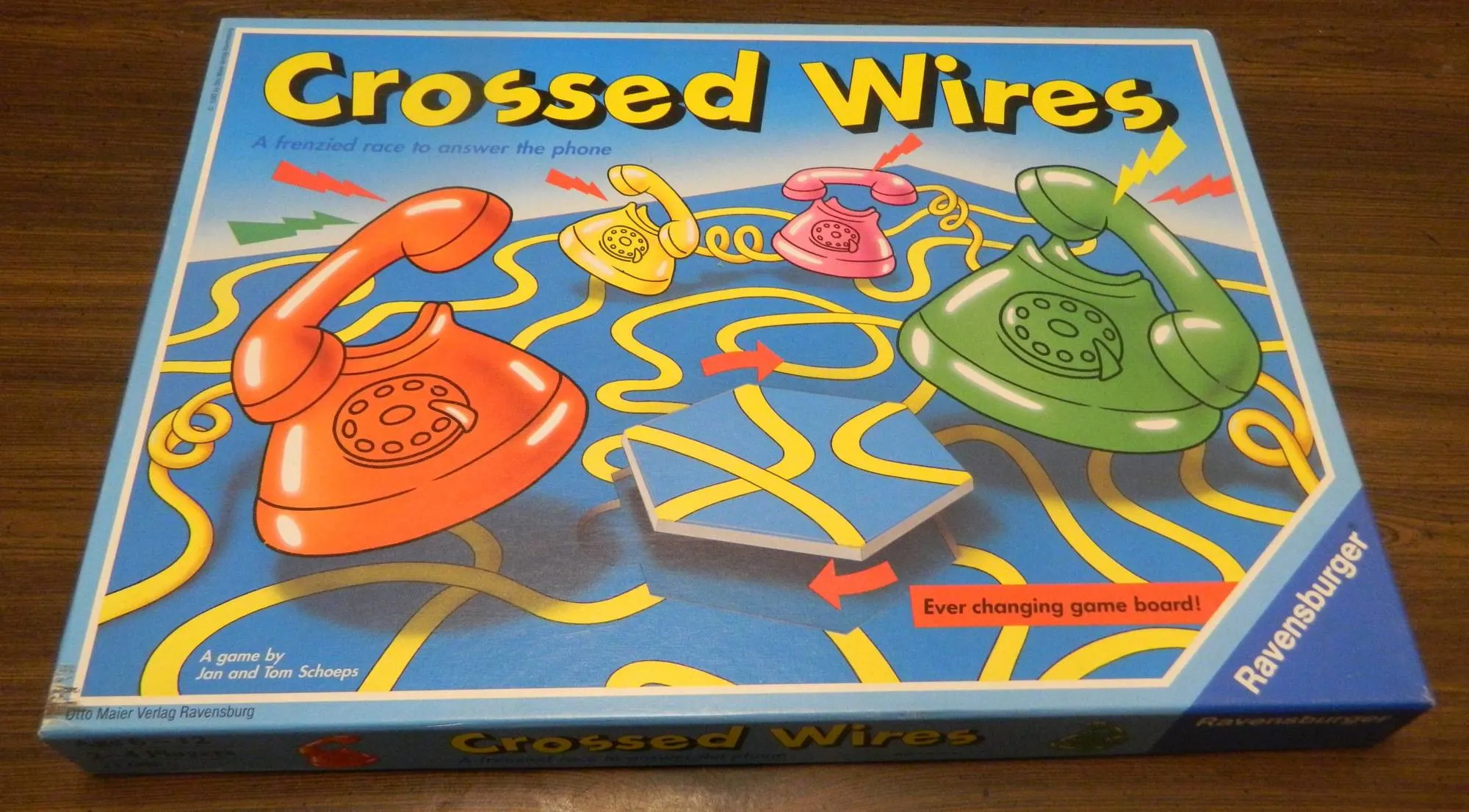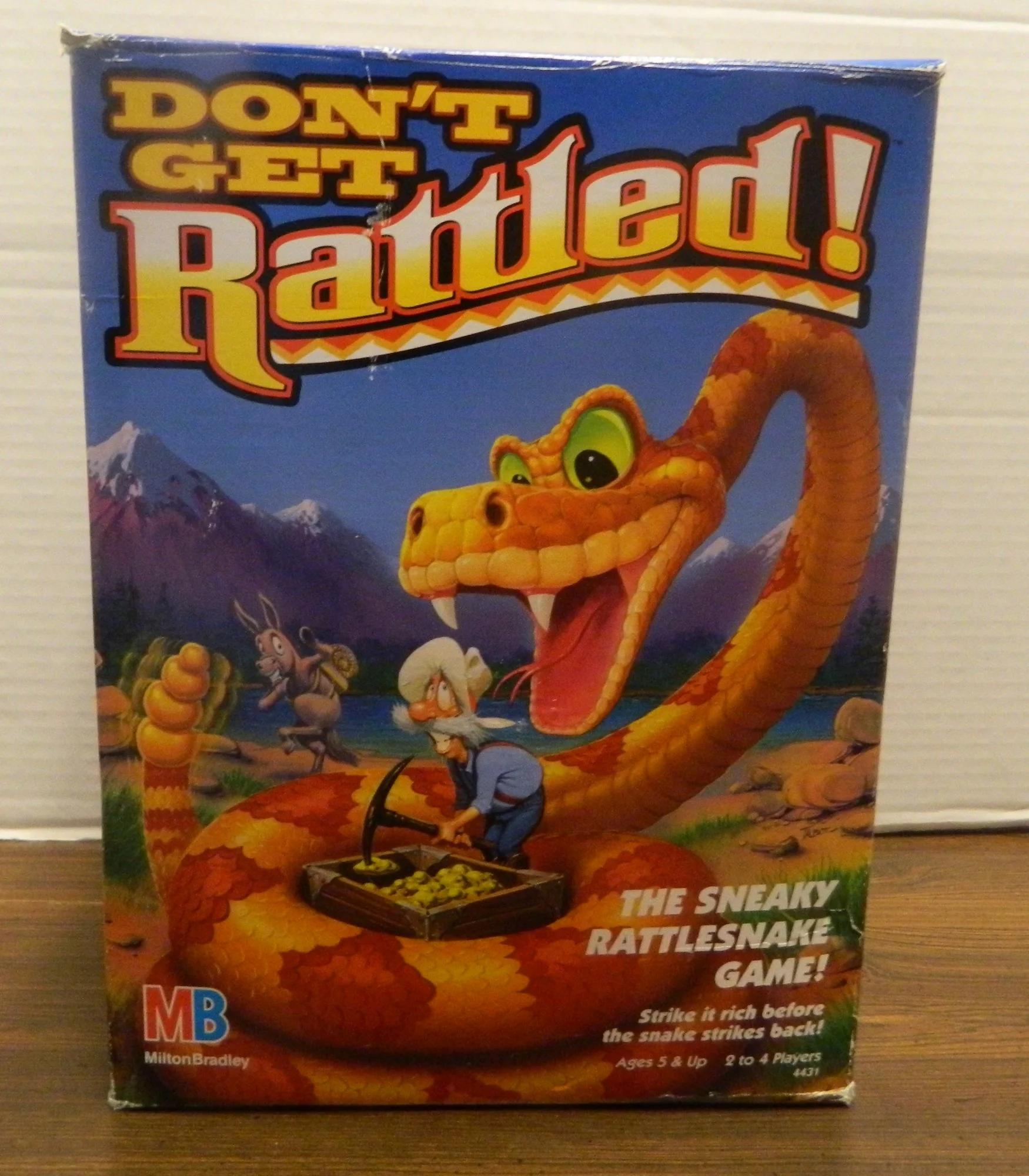Most people agree that the board game revolution in the United States started around 1996 with the introduction of the Settlers of Catan to the United States. Before the mid 1990s most board games were made by either Milton Bradley or Parker Brothers and weren’t particularly strategic. Games during this period were mostly made for families and were usually just roll and move games. After the introduction of Settlers of Catan the board game industry changed drastically in the United States where publishers started to try out new ideas. While it is rare to find games created before 1996 that actually tried mechanics similar to what you find in board games today, there was the occasional game including today’s game Extinction. Extinction tried to take a traditional set collecting game and combine it with some new mechanics for the genre. Extinction deserves some credit for being before its time with some interesting mechanics, but it ultimately leads to a game that is kind of boring.
How to Play Extinction
Setup
- Remove the three end period cards from the deck.
- Select a dealer. Shuffle all of the remaining cards and deal ten cards to each player.
- Place five cards face up in the middle of the table. Then create a draw pile based on the number of players:
- 2 players: 8 cards
- 3 players: 9 cards
- 4 players: 12 cards
- 5 players: 15 cards
- 6 players: 18 cards
- Separate the rest of the cards into three piles of similar sizes. One period card will be shuffled into each pile of cards. Place the pile with the Cretaceous Period card on the bottom of the pile. The pile with the Jurassic Period card will be placed in the middle. The pile with the Triassic Period card will be placed on the top. This deck will be placed off to the side.
- The player to the left of the dealer will be the first player.
Anatomy of a Card
Period Dinosaur Lived: The period that a dinosaur lived in. This comes into play during scoring.
Dinosaur’s Size: Dinosaurs can be small, medium or large. This is used during the Gene Pool phase.
Name: The name is used to create herds of the same dinosaur.
Food Type: The symbol determines whether the dinosaur is a plant eater, egg eater, or meat eater.
Playing the Game
On a player’s turn they will take an action and then draw a card. The actions that a player can take are as follows:
- Create a herd.
- Play an eggs card.
- Play an egg eating dinosaur card.
- Replace an eggs card with one or more matching dinosaur cards
A player can only take one of the four actions. They can also choose not to take any of the actions.
The player will then get to draw a card. They can either take one of the face up cards in the middle of the table or the top card from the draw pile. If one of the face up cards are taken, the top card from the draw pile will replace the card that was taken.
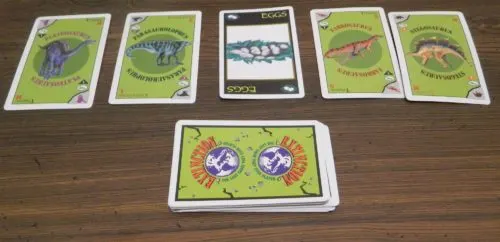
At the end of this player’s turn, they can either draw one of the face up cards or the top face down card.
After the player has taken their turn, play passes to the next player to the left.
Creating A Herd
A herd consists of two or more plant eating dinosaurs of the same type. When a player decides to create a herd they play the cards out in front of themself. The player will then score points based on the size of the herd (see Scoring section). Once a herd has been formed, cards can’t be added to it unless an eggs card is played to the herd.
A player can only have four herds in front of them at the same time. Players also can’t have more than one herd of the same type. Once a herd is played it can’t be removed by the player unless the herd is destroyed by a meat eating dinosaur or a catastrophe.
Play An Eggs Card
When a player would like to add cards to a herd, they must first play an eggs card to the herd. The eggs card will only apply to the herd that it is played to. The player won’t be able to add dinosaurs to the herd until a future turn.
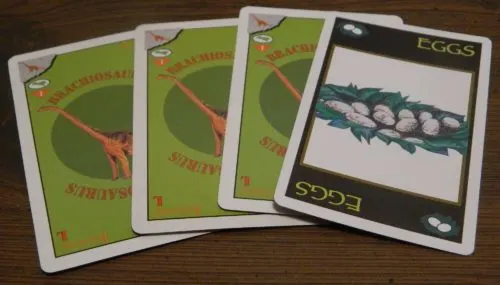
This player has added an eggs card to this herd. This will allow them to add more cards to the herd on a future turn.
Play An Egg Eating Dinosaur Card
When a player plays an egg eating dinosaur they choose a player they would like to target. The current player will play the egg eating dinosaur on the eggs card of their choice. The eggs and the egg eating dinosaur card are discarded.
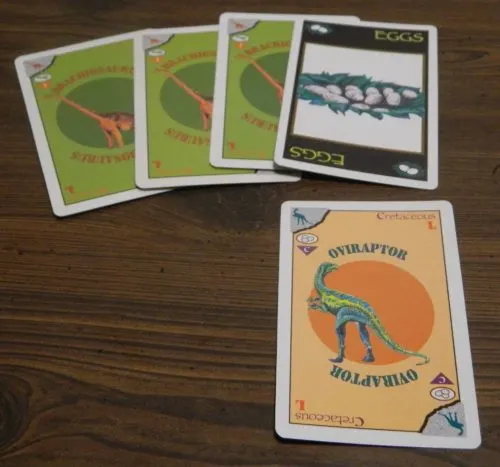
A player has played an egg eating dinosaur against this player. The egg eating dinosaur and the eggs card will be discarded.
Replace An Egg Card
On a turn after the eggs card is placed, a player is able to replace the eggs card with dinosaur cards that match the other dinosaurs in the herd. To use the eggs card it is discarded. The player can then add as many of the corresponding dinosaurs to the herd as they want.
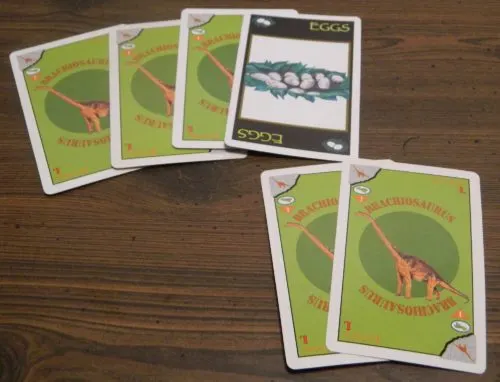
In a previous turn this player added an eggs card to their Brachiosaurus herd. On their current turn they have added two more Brachiosaurus cards to the herd. After adding the additional cards, the eggs card is discarded.
Gene Pool
When the last card is drawn from the face down draw pile, a gene pool phase occurs. All of the players choose one of the cards from their hand to add to the gene pool. The only time a player can use a meat eater or catastrophe card is during this phase. Once everyone has chosen a card, all of the cards are shuffled. One card is then dealt to each player. Depending on what card a player is dealt, the card will either be added to the player’s hand or will immediately go into effect.
If a player currently has no herds, all cards except for catastrophe cards will be added to the player’s hand. Catastrophe cards will go into effect immediately.
If a player has at least one herd some cards will go into effect immediately while others will be added to the players hand.
- Meat Eaters: Immediately eat dinosaurs (see below).
- Egg Eaters: If the player has an egg out in front of them, the dinosaur will eat the egg. If the player has no eggs, the card is added to their hand.
- Egg Cards: The egg card will be added to the player’s hand.
- Plant Eating Dinosaur: If the player already has a herd of that type of dinosaur, the dinosaur is immediately added to the herd. If the player doesn’t already have a herd for the dinosaur, the card is added to their hand.
- Catastrophe: The card goes into effect immediately.
After all of the cards have been handled, a new round is played. All of the face up cards in the middle of the table are discarded. Five new cards are placed in the middle of the table. A new draw pile is also formed as described in the setup section. The next player will then take their turn and the game continues as normal.
Meat Eater Cards
A meat eater card will attack the player that it is dealt to in the gene pool phase. A meat eater card will eat herds based on the size of the meat eater:
- Medium Sized Meat Eater: The carnivore will either eat two small dinosaurs or one medium dinosaur.
- Large Sized Meat Eater: The carnivore will either eat three small dinosaurs, two medium dinosaurs, or one large dinosaur.
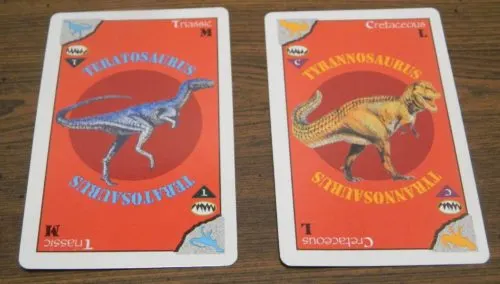
The card on the left is a medium sized meat eater and the card on the right is a large sized meat eater.
If the meat eater eats more than one dinosaur, they will eat all of the dinosaurs from the same herd. Meat eaters will attack the smallest herd that allows them to eat all the dinosaurs that they are allowed to eat. The meat eater and all of the dinosaurs they eat are placed in the discard pile.
Catastrophe Cards
When a catastrophe card is played into a gene pool, the player that gets the card will read its effect out loud. The player who is dealt the card is the “selected player”. The text on the card will go into effect immediately.
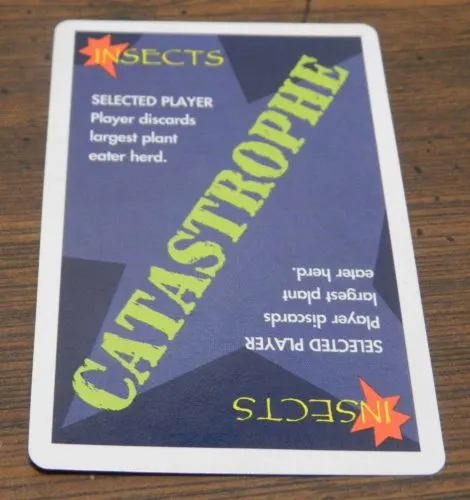
When this card is played in a gene pool, the player who is dealt the card has to discard their largest plant eater herd.
Extinct Herds
If an entire herd is eliminated due to a meat eater or a catastrophe card, the herd may go extinct. The player has until the end of their next turn in order to place a herd to replace the herd that was eliminated. The new herd does not have to be the same type of dinosaur or have as many dinosaurs as the herd that was eliminated.
If the player is unable to play another herd by the end of their next turn, they will take an extinct herd token. This will count as one of the player’s four herds for the rest of the game.
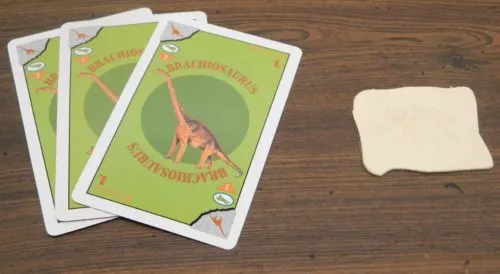
One of this player’s herds have gone extinct. The extinct herd will count as one of the player’s four herds for the rest of the game.
End of Period
A period will end when one of the period cards are drawn. Players will score points based on the herds they have in front of them (see Scoring section).
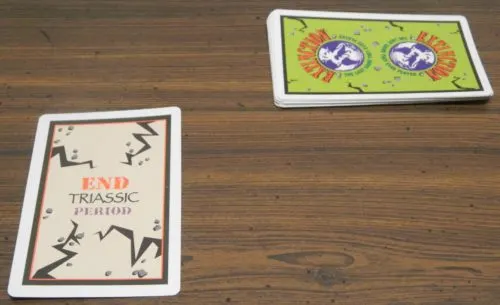
The End Triassic Period card has been drawn ending the current period. The players will score points based on their current herds.
After the scoring is completed, all of the face up cards in the middle of the table along with the face down draw pile are discarded. The face up cards and draw pile are replaced as described in the setup section.
After the Cretaceous Period card is drawn there will be one final scoring round. The game will then end.
Scoring
Players will score when a herd is first played or when one of the end period cards are drawn. Herds will score points based on the number of dinosaurs in the herd. Points will be scored as follows:
- 1 dinosaur: 1 point
- 2 dinosaurs: 2 points
- 3 dinosaurs: 4 points
- 4 dinosaurs: 6 points
- 5 dinosaurs: 8 points
- 6 dinosaurs: 10 points
- 7+ dinosaurs: 12 points
During end of period scoring herds can score bonus points. If a herd of dinosaurs’ period matches the period card that was drawn, the herd will be worth double points.
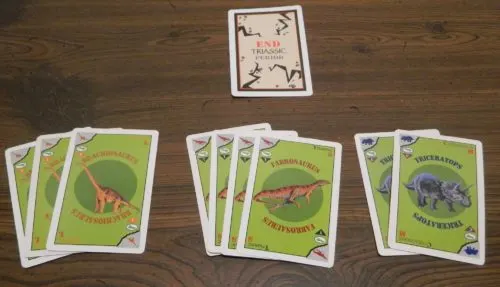
The end Triassic period card has been drawn. This player will score the following points. The Brachiosaurus herd will score four points. The Fabrosaurus herd will score twelve points (six for the cards which are doubled because the cards’ period matches the current period). The Triceratops herd will score two points.
Throughout the game players will also score bonus points for reaching certain milestones:
Creating A Herd With At Least Four Cards
- First Player: 10 points
- Second Player: 8 points
- Third Player: 6 points
- Fourth Player: 4 points
Having Four Herds At The Same Time
- First Player: 12 points
- Second Player: 10 points
- Third Player: 8 points
End of Game
The game ends after the cretaceous card is drawn and scoring is conducted. The player who scored the most points wins the game.
My Thoughts on Extinction
At first glance Extinction looked a lot like an educational game. There is a surprising number of educational board games based around dinosaurs after all. After examining the game a little more though it actually looked kind of interesting as it combined a set collecting game with some mechanics that were pretty original for a game back in 1993. While I am not a huge fan of set collecting games, I don’t mind occasionally playing a game from the genre.
The main mechanic of Extinction is to try and create herds of the same dinosaur. This is key as this is the only way to score points in the game. At first this mechanic seems pretty basic as it is the premise of pretty much every set collecting game. The more you collect of a specific dinosaur the more points you score. As the game only lets you have four different herds at the same time, the game emphasizes creating larger herds as they are easier to protect and progressively score you more points. Normally you would probably want to play your herds as quickly as possible in order to score points for them as well as have them available if one of the end period cards are drawn. You want to take your time playing herds though as you don’t want to create a herd that you can’t later add to as you are limited to only four herds.
The more interesting reason why you might want to wait to play a herd is that it is not always easy to add cards to a herd once it is played. It is usually easier to just play a large herd right away. There are only two ways to add cards to an already played herd. First you can draw a matching dinosaur in the gene pool phase. Otherwise you can use an eggs card. I thought the egg mechanic was really interesting even though I don’t think there are enough eggs cards in the game. Basically you can play an egg to one of your herds which allows you to add more dinosaurs to a herd. This wouldn’t be that original except that other players can play egg eating dinosaurs in order to eat the eggs before you are able to add dinosaurs to the herd. This requires timing as you need to play the eggs right before you plan to add cards to a herd so there is less time for the egg to be eaten by a dinosaur.
The other major addition to Extinction comes from the gene pool phase. In the gene pool phase all of the players put one card into the pool and then one card gets dealt to all of the players. I found this mechanic to be pretty interesting as it adds quite a bit of risk/reward to the game. Most of the risk/reward comes from not knowing which card you will be dealt. Therefore you can either put a meaningless card into the pool or you could try to put in a card that will either help you or hurt the other players. You might want to put that meat eater or catastrophe card into the pool, but there is always a chance that you will end up drawing it.
Then there are the meat eating dinosaurs and the extinction cards. These cards can really mess with players. Meat eating dinosaurs can decimate a herd. The catastrophe cards can be much worse. Some of the cards can be downright evil as they utterly destroy the player(s) that they impact. I don’t know exactly what to think about these cards. Some of them can be way too powerful. At the same time whenever you play one of them you are taking the risk that it will impact you. Maybe it was just because I played the game with a lot of risk averse players, but this usually lead to players avoiding the cards altogether. This was due to not wanting to take the risk of drawing the cards themselves. This leads to the cards clogging up your hand and mostly remaining unclaimed in one of the face up draw piles.
The meat eater and catastrophe cards bring up the extinction mechanics which I could have done without. Basically when one of those cards wipe out one or your herds, you are at risk of losing the herd for the rest of the game. In addition to losing the points you could have scored from the herd, you lose the ability to play one of your herds for the rest of the game. This might not be be a huge problem towards the end of the game but it can be devastating early in the game as you will be playing at a disadvantage for the rest of the game. The good news is that it is usually pretty easy to avoid. To prevent against losing one of your herds from extinction you should always keep two matching dinosaurs in your hand that can quickly form a new herd. It is usually not that hard to have a herd in waiting so it doesn’t end up impacting the game very much. For this reason I don’t know why the mechanic was even included.
The final unique mechanic that Extinction brings to the table regards the scoring. Most of the scoring is pretty similar to your typical set collection game as you score more points for the more cards you have in a set. There are two unique ways to score points though. First players score bonus points for being the first players to create a herd with four dinosaurs and to have four herds at the same time. The more interesting scoring mechanic is the fact that you can score bonus points if your herd of dinosaurs match the period of the end period card that was just drawn. This doesn’t drastically change the gameplay but it will impact your decisions. You want to make sure the dinosaurs in your hand that match the current period are played so they can score double points. Dinosaurs of the Cretaceous period are also naturally worth more points as you have more time to build up their numbers to score them at the end of the game.
As far as the theme I don’t really have a strong feeling either way about it. Dinosaurs make for a good board game theme, but so many board games use the theme that it gets repetitive after a while. While Extinction is not the educational game that I originally thought it might be, there are still some light educational components to the game. The game could help you learn about the different periods and which dinosaurs lived during each period. Otherwise the game doesn’t have much educational content.
So at this point in the review I would normally say that Extinction is a pretty good game that I enjoyed playing. Unfortunately I can’t really say that though as it felt like the game was missing something. Extinction is far from a bad game but it is not great either. Normally I would like a game like Extinction quite a bit, and yet there is something standing in the way of Extinction being as good as it could have been. For some reason the game is just kind of boring. I wouldn’t mind playing the game again but I don’t ever see actively wanting to play it. I can’t really put my finger on the exact reason why though.
I think the biggest problem with the game is that it feels more complicated than it needed to be. Individually none of the mechanics are too difficult but together it feels like the game is bogged down by too many rules. Set collection games are usually meant to be simple and straight to the point. The addition of all of the new mechanics drag down the whole experience in my opinion. It makes the game more difficult than it needed to be as it takes some time to explain the rules. You won’t fully understand the game until you are through quite a bit of your first game. This isn’t helped by the official rules which aren’t written well. I don’t know exactly which mechanics the game should have ditched, but it feels like too much is in the game.
The second contributing factor to Extinction not being as good as it could have been is that it is not particularly original. The game adds some mechanics to your typical set collection game. At the end of the day though it doesn’t play that much different than many other set collecting games. I like set collecting games but after a while they all seem to blend together unless they have a truly unique mechanic that changes everything. Unfortunately Extinction doesn’t have that mechanic. Some of the additions add some interesting ideas to the game but none of them do enough to make Extinction stand out from the rest of the set collecting genre.
On top of all of this I think games of Extinction take too long. While set collecting games can be fun, as you are doing the same thing the entire game they get repetitive after a while. Therefore most set collection games are better at around 20-30 minutes. I would expect most games of Extinction to take closer to an hour. I had fun with Extinction at first, but it started to drag a little towards the end. If games of Extinction were closer to 30 minutes I think the game would have been more enjoyable.
Finally Extinction’s components could have been better. I thought the extinction tokens were pretty cool as they are engraved to look like dinosaur skeletons. They are only made of cardboard though. The game comes with a lot of cards, but the quality is pretty average. If you take care of the cards they should last. The cards’ artwork could have used some work though. The card layout is not bad, but it feels like the artwork is clip art. The component quality doesn’t distract from the gameplay but it is nothing special either.
Should You Buy Extinction?
At first I didn’t have high expectations for Extinction as it looked like another dull early 1990s card game. After reading the rules though I became intrigued because the game actually had some really interesting rules for a set collection game from the early 1990s. At its core Extinction is a set collection game where players are trying to create herds of dinosaurs. The game adds some interesting mechanics to how you form herds which allow players to mess with each other’s herds. This could have lead to a surprising amount of strategy for this type of game. Extinction has all the makings of a good game, but it feels like something is missing from the game. The game is just kind of boring. There are too many rules in the game, it feels like every other set collection game, and it takes too long. Extinction is not a horrible game, but it could have been quite a bit better as well.
If you have never really cared for set collection games, Extinction probably won’t be for you as there are considerably better set collecting games than Extinction. Also if you already own a lot of set collecting games, I don’t know if Extinction is unique enough to add to your collection. If you like set collecting games, dinosaurs, and think the concept sounds interesting; it is probably worth picking up Extinction if you can get a good deal on it.
If you would like to purchase Extinction you can find it online: Amazon, eBay

